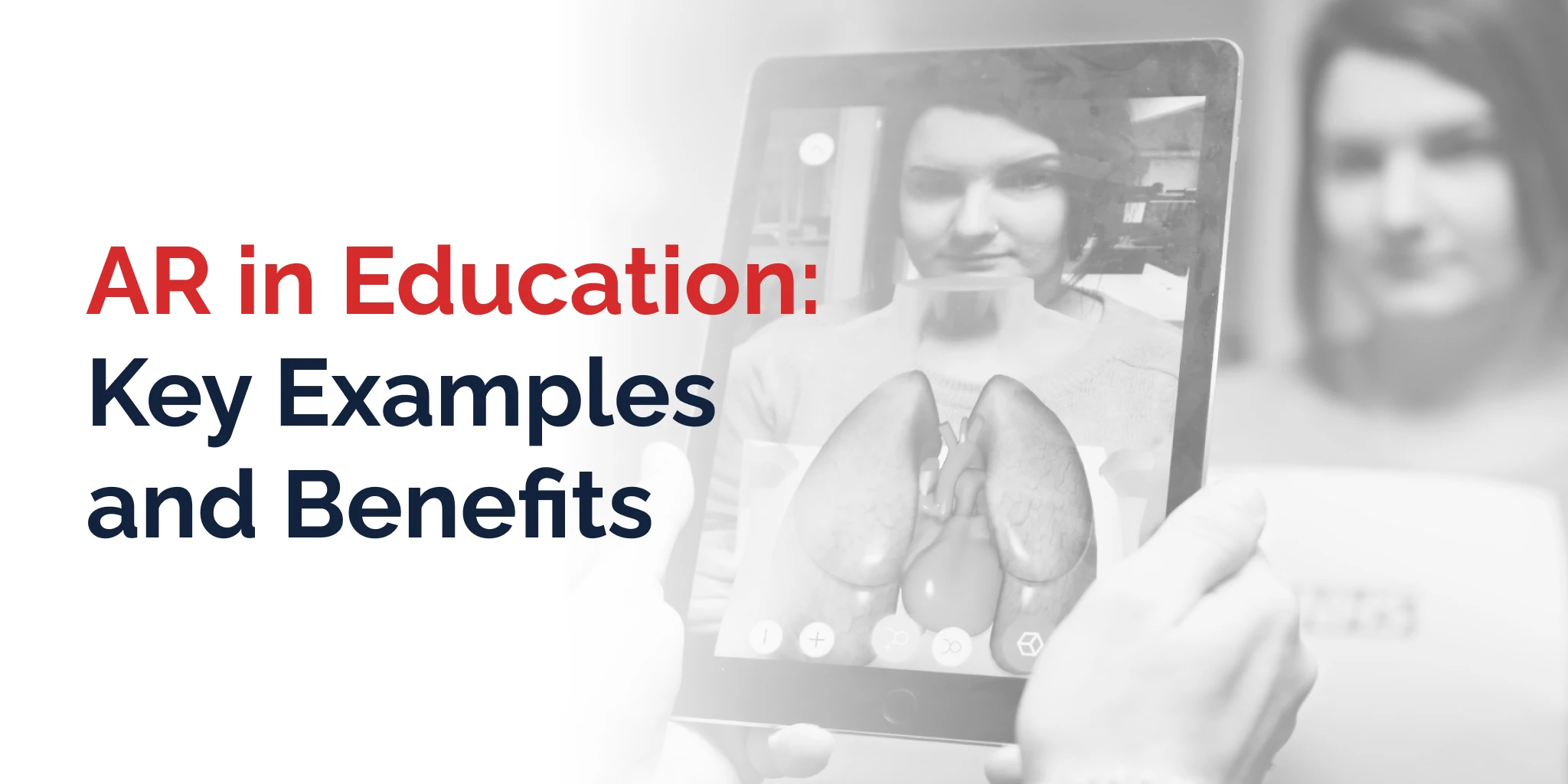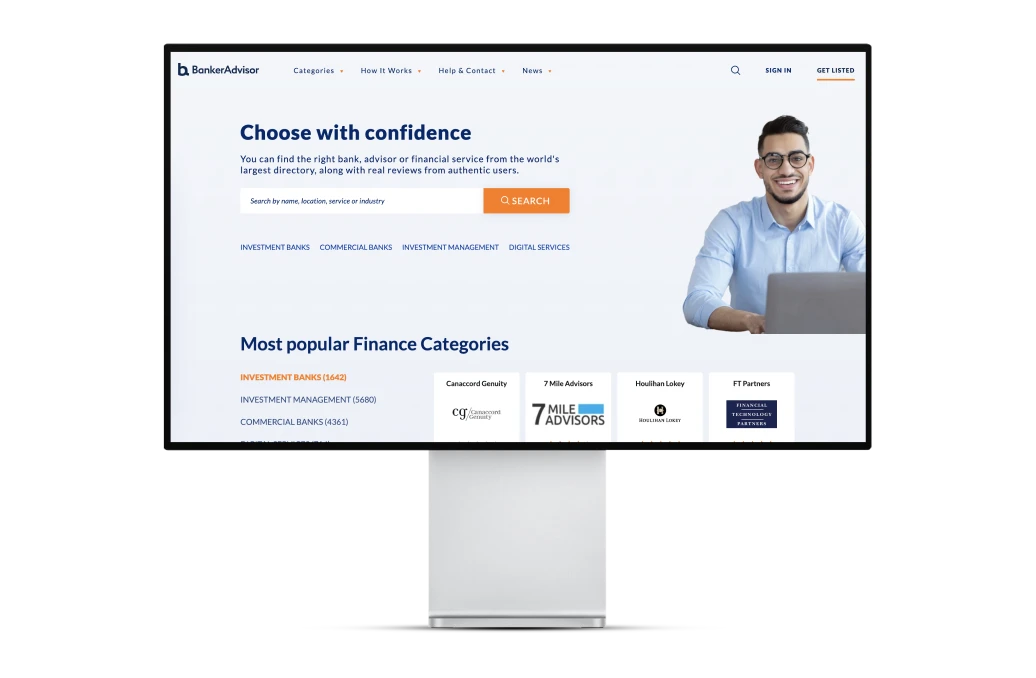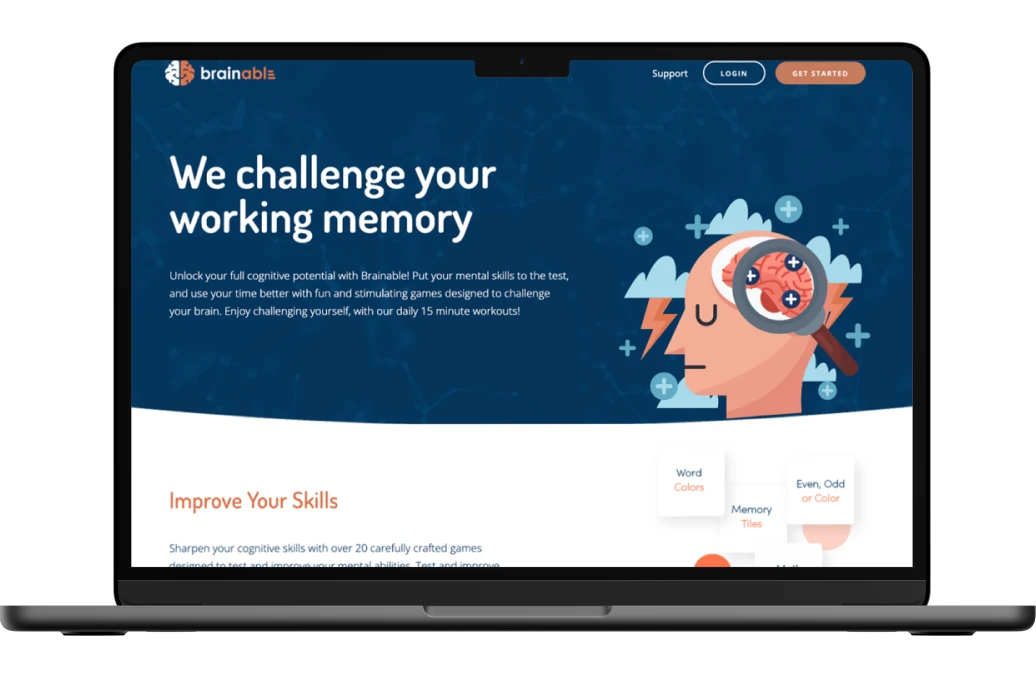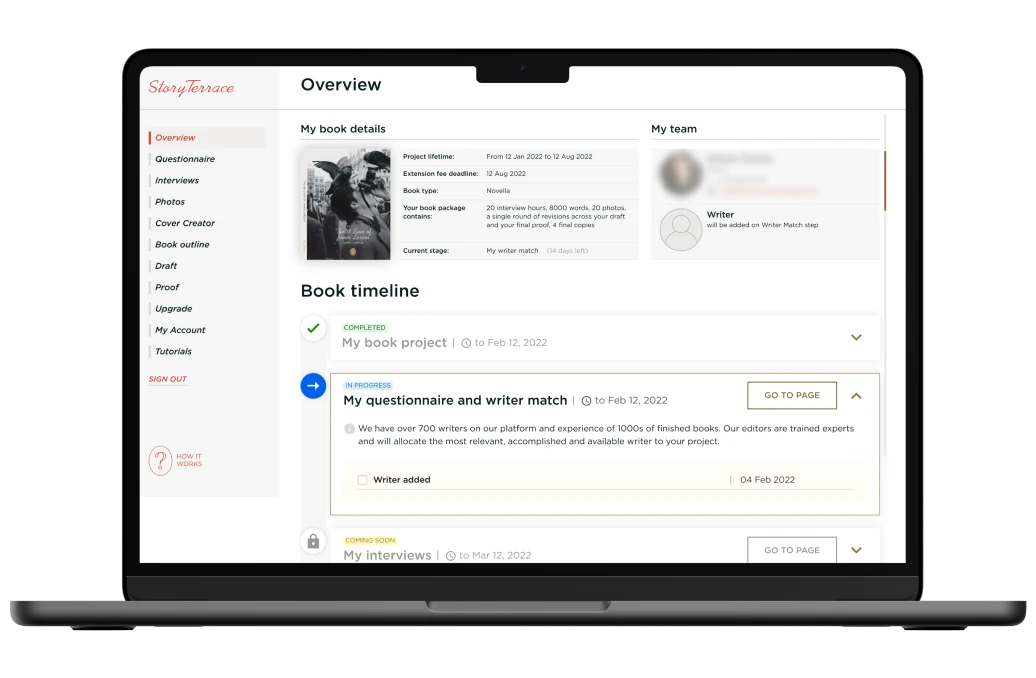Augmented reality is a technology that can completely change your vision of education.
Augmented reality in education can change the way in which children apprehend learning material. After all, it gives a chance to transform the very approach to educational institutions. Instead of bland places, they can turn into colorful spaces full of new information. The AR in education can make many virtual things appear in real-world environments, creating a powerful incentive for creativity. In short, you can transform the very nature of learning with platforms of this type. We recommend not to waste the opportunity in question. After all, it gives a way to hold the attention of children for longer. How to use AR in education? Don’t hesitate to utilize it for the improvement of all learning processes.
What is Augmented Reality in Education?
Many people associate the virtual environments of AR with gaming or, at best, communication (for instance, Snapchat). The outcome is not surprising: games such as Pokemon Go or Witcher: Monster Slayer obtain the highest attention of the press when it comes to mobile devices. Ultimately, however, the situation is very different. Just as you can use AR for gaming, augmented reality in education is also highly potent. For example, imagine that your math teacher can now show concepts directly in the classroom. All you have to do is point the camera at the place. AR gives relevant 3D models and other strong elements. Thus, the future of augmented reality in education is very bright.
How to Use AR in Education?
AR in education can have many potential uses. How utilize the augmented reality app you have? Firstly, try to showcase some spatial information with it. For instance, you can do a virtual dissection if you study in a biology class. In this way, one can remove the need to use a real animal and resort to violence in class. Secondly, it’s a strong tool for creating a potent virtual classroom. You can try to create an environment full of AR elements in this way. For instance, it’s possible to showcase some books and even their authors in this manner. In short, you have a wide range of options in the presented case. The role of augmented reality in education is likely to grow in the upcoming years.
Benefits of Augmented Reality in Education
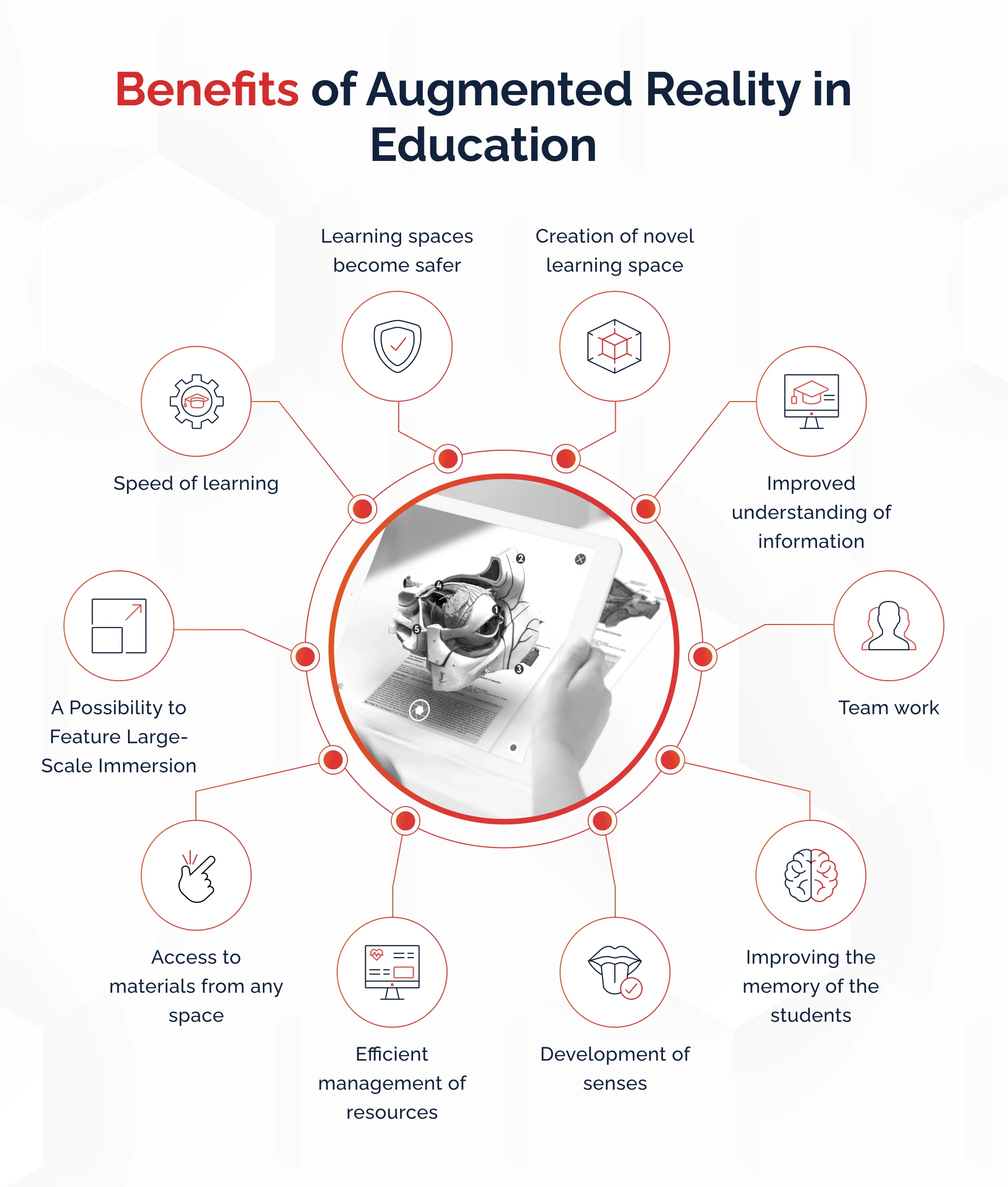
We have many benefits of augmented reality. Let’s take a look at them:
More interest on the part of the students
One of the most difficult things in education is keeping the attention of the students. They usually have no intention to be overly enthusiastic about learning. Virtual objects in the classroom space can change the situation. AR for education adds surreal elements to education, making it more enticing. Moreover, the technologies of this type are essential for adding game elements to education. Hence, you can expect more attention from the students in your classrooms with AR.
Creation of a novel learning space
The best way to ensure strong learning opportunities is to make the process all-pervasive. What do we mean by this? Augmented reality in education creates a learning space within the learning space. In short, it gives a chance to enhance the very scope of learning. Instead of having to rely on your whiteboard, for example, you get a chance to turn everything into a learning space. Since smartphones are all-pervasive, it’s possible to describe more complex processes with the use of the outlined technologies. You can often engage in a sort of background training with this technology.
Improved understanding of information
Our experience in education shows that understanding some information in
classroom settings is often very difficult. In this regard, augmented reality in education changes the whole game. One of the most difficult aspects of learning for many students includes spatial concepts. For instance, it’s not uncommon to have issues with geometric figures. Digital content can show many of the concepts in a real-life environment. As a result, it’s possible to greatly reduce the time it takes to explain something to students.
Teamwork
Another positive impact of AR in education undoubtedly stems from the ability to enable collaboration. For example, you can use technology to ask the students to create some objects for the in-class examples in teams. The collaboration element of AR technology is not surprising. It stems from the online games and chats, showing that AR now has a potent cooperative element. Don’t waste this opportunity to augment learning in the classroom scenarios.
Improving the memory of the students
Augmented reality in education makes many things much more memorable. It’s one thing to see some mathematical concept on the whiteboard. An absolutely different reality arises when you can view it in reality and even walk around the relevant figure. This approach provides students with opportunities to memorize more information as the technology uses more parts of the human brain in the memorization process. Humans think in an embodied way. Thus, if you the motor-related parts of the brain for learning, your chances of teaching something grow significantly. It’s the reason why a field trip is so good for learning: you simply get a chance to maximize the movement-related benefits
Development of senses
One of the worst problems stemming from modern education lies in the fact that it’s too abstract in nature. Students learn formulas without getting a chance to see their real-life applications. As a result, not only does the student engagement fall but also their ability to think in spatial terms. AR in education solves this problem in a radical way by giving some spatial features to the space around students.
Efficient management of resources
AR makes the need to invest in the learning spaces of physical nature less prominent. One of the key benefits of augmented reality in education lies in its ability to create learning spaces almost everywhere. Are you in a bare classroom and have no ways to improve the space? Don’t worry! AR can fill it with all the relevant information. This innovative technology represents a perfect space for enhancing learning-related opportunities.
Access to materials from any space
A big strength of mobile technologies lies in their promotion of access to materials from anywhere. Do you have to engage in distance studying? Extended Reality will solve all your needs by projecting the relevant information into any space. Augmented reality for education can, thus, play a tremendous role. After all, it enables the ability to take the learning space together with a smartphone. Thus, you will no longer have to rely on your classroom. That’s what AR online education means.
A possibility to feature large-scale immersion
What does AR stand for in education? In our opinion, it’s a chance to dive into the subject you’re learning. No professional training is possible without hands-on experience. AR gives this type of experience to the users. Their educational experiences are enriched with a large set of very practical applications. As a result, AR greatly reduces the difficulties in education.
Speed of learning
Obviously, augmented reality in education and training can greatly reduce the time it takes to learn a concept. It removes the problems with spatial understanding. As a result, the students can get more opportunities to obtain a higher level of education.
Learning spaces become safer
When it comes to applications for education, AR is also a potent way to avoid dangerous situations in the classroom. After all, the method enables the transformation of many potentially dangerous activities into something much safer. For instance, what does AR mean in education related to chemistry? Above all, it allows for the showcase of some reactions without the usage of the actual equipment.
Examples of Augmented Reality in Education
Adding technology to a learning program won’t immediately transform learners’ results, but it’ll certainly produce gradual shifts in their outcomes. Let’s see how AR continues to move education to a new level through personalized learning systems, approaches, and methodologies in assessment, management, and teaching.
AR for early learners
AR providers continue to develop apps that change how we read books, learn art and science, experiment, and develop our logical perception.
Let’s move on to AR use cases.
Catchy Words AR is an exciting way to learn new words through interactive lessons. When playing the game, students walk around the classroom, find the letters, and make the right word.
Quiver Masks allows students to fall in love with books. When reading the book, students create their own AR characters using their perceptions and masks. This way, it helps them easily remember and retell the stories.
Photomath is a comprehensive math learning platform for students of different levels. It offers a pool of step-by-step solution methods for math problems, interactive graphs, word problem instructions, video learning, an advanced calculator, etc.
AR in classroom
Recent statistics say that AR in the education sector is expected to grow from $1.37 billion in 2021 to $5.3 billion in 2023. More and more educators are eager to try technology in their educational programs, whereas 90% of them agreed that AR-based lessons can stimulate students’ engagement. The mix of AR and VR in class is far more appreciated by students; almost 97% of students noted they would like to study a course with AR implementation.
There are many free-to-download, available apps that are practical to use in classrooms. Let’s see some of their usage below.
MathAlive is an AR product, the aim of which is to show that math is everywhere. The service is a de facto AR-based virtual teacher that uses various video and image resources to promote mathematics-centric messages.
Google Expeditions provides the users with 3D AR tours and 3D objects that students can place in the classroom. With this AR platform, teachers can immerse students in entirely new immersive experiences with interesting sites and artifacts along the way.
JigSpace is an AR app developed to create and share 3D or augmented reality educational and professional presentations. It’s an exciting experience, allowing students to create ancient artifacts, or biology-related layers for bringing a better understanding of the topic.
As you may see, the apps of this type in education are numerous. You just have to pick the best solution.
AR in remote learning
Due to the Covid-19, distance learning isn’t a new thing in modern education. And thanks to augmented reality, gamification, and virtual reality, students can experience a new way of learning via digital devices. Thanks to edtech and immersive technologies such as AR, 120 million children and students have the opportunity to study remotely.
Research shows an increase in the results of the students’ assessments at 14%. The more tasks students complete around one theme or subject, the better they progress and the better rewards they achieve. VR gamification elements create a smart competition and social interaction, helping students strive for their learning purposes. 67% claim they’re more motivated during gamification, and one of the most useful aspects of VR game-based learning is getting the analytics, which allows students to better understand their strengths and weaknesses and define gaps for improvements.
Lack of practice is one of the cons of remote learning. But VR and AR break the gap between distance and real-life learning. Virtual practice improves the quality of learning and students’ retention by up to 90%. AR allows students to use a virtual headset with their headphones to immerse themselves more in a better learning environment. For instance, it can be virtual reality surgery to let the students experience real-life medical practice or pair programming, where teachers can follow the screen of the students and guide them through the specific learning process.
Virtual field trips let students explore historical sites and landmarks to better understand and learn about the historical period of a certain epoch through VR simulations.
Through virtual science experiments, students can conduct experiments and explore scientific concepts without the need for equipment.
Learning a new language is already not a tough task for modern learners. Thanks to various AR apps, students get unique learning through visual and audio aids, including virtual conversations with real-world experienced tutors all over the world.
AR for museums
Museum is another field where visitors can engage with an interactive exhibition and exciting knowledge transfer. In museums, there is a wide use of 4K multitouch displays, which bring something new to existing art works and engage wider audiences. When viewing the exhibitions through AR, the visitors get more explanations of the artist’s works. Thanks to this technology, the museums can show digital versions of artists next to their work, or use 3D personas to provide narration to visitors and bring the objects and scenes to life.
The National Museum of Singapore set up an immersive installation, focusing on 69 images from the William Farquhar Collection of Natural History Drawings. In turn, the visitors downloaded an AR app, used their camera on their phone or tablet to learn the facts, and interacted with 3D animations of the painting items, which were plants and animals.
De Young Museum, San Francisco, held an innovative partnership with Snap Inc. to virtually dress visitors in evening wear ensembles by well-known clothing artists—French designer Yves Saint Laurent, Italian couturier Valentino, and Bay Area-based clothing artist Kaisik Wong.
Although we can’t list all the AR applications in museums, we’ll summarize other use cases briefly. AR is used for the below cases with the single purpose of letting users interact with objects dynamically in new dimensions and enrich their knowledge about specific artworks:
- through bringing exhibits and their items to life;
- through visualizing ancient artifacts;
- through adding an informative, clickable explanation on top of the artwork;
- displaying digital avatars of artists or curators;
- through AR games allowing the visitors to feel the participants and unlock AR animations, collect challenges, interact with augmented displays, and other tasks.
AR can show the art works no matter the distance, thus reaching a wider audience across the globe.
AR for professional training
Augmented reality is useful in many subject matters, from education to military training. In this section, we want to focus on three areas where AR transforms professional training: healthcare, aerospace, and military training.
Augmented reality in healthcare education
The best thing about AR-powered healthcare training is that it helps to develop the skills of many specialists, medical students, and caregivers. It aims to facilitate and improve the different aspects of care and simplify medical operations. There is a continuous rise in the use of medical gadgets for real-time monitoring in medical education, offering professionals more detailed views of the patient’s bodies and providing efficient visual guidance on different medical conditions. AR-based training, which imitates true-life scenarios like defense, disaster management, firefighting, and surgery, is highly beneficial to help develop skills through machines and equipment in a safe environment.
Using AR in healthcare significantly improves the efficiency necessary for practical training and increases accessibility through remote training without the need for special equipment. What’s more, by simulating numerous health conditions, it provides the learners with a more realistic and interactive learning experience without taking risks. Thanks to machine learning algorithms and analytics, AR systems can offer more personalized learning, considering the weak and strong skills of the students.
Examples of AR in healthcare education
Learning anatomy is one of many AR use cases. Human Anatomy Atlas is an AR app allowing students to interact with a digital human body from all 3D angles, learn medical animations of pathologies, and share learning experiences, including flashcards, with students.
Surgery is another AR application. The era of training on mannequins and cadavers has slightly passed, and AR offers students a more comprehensive experience. It creates virtual patients and real-like environments where students can practice their skills. In addition, integrated cameras in mannequins allow for the recording of training videos and the subsequent assessment of the student’s progress.
The augmented reality platform Proximie gives healthcare professionals the option to consult and assist people remotely when there is no specialist on duty or a healthcare professional with specific expertise. Recently, a specialist from Seattle guided a surgical team nearly 5,000 miles away through the AR platform Proximie.
Augmented reality in the space industry
AR is also used in the space industry to overcome technical issues such as aerospace maintenance, repair, and overhaul with advanced remote tech support solutions. Also, its application helps to improve visualization, analysis and interaction with space-related data. AR breaks the gap for remote video consultation with tech experts on complex procedures. The technology provides a better training experience for the students as they can explore 3D models of aircraft components, service procedures, and AR manuals while getting the best recommendations and guidance in real time. So, let’s explore the applications of AR in practice.
Examples of AR in the space industry
The capabilities of VR and AR help to improve planetary space exploration. Microsoft HoloLens are headsets that project virtual images over the real world. It helps space researchers plot the courses and targets for the Mars rover, explore and plan the new Mars locations, and determine the accurate distances and angles of Martian locations.
The Sidekick project allows engineers and experts to provide their help to astronauts on the International Space Station when doing complex procedures. Sidekick is an AR app offering astronauts many support functions, like equipment setup and checks. With remote expert mode, a ground operator provides the astronauts with real-time guidance on everything the astronaut on the ISS needs.
One of the facilities that NASA uses to train astronauts is the Active Response Gravity Offload System. It recreates real-life mission scenarios in reduced-gravity environments. It helps astronauts acclimate to the conditions outside Earth’s boundaries.
Augmented reality in military training
As the military sector is constantly growing, armies also have to keep up with new military opportunities and technological advancements for training and combat enhancements. AR is used in the military to improve combat training, vehicle maintenance, and mission planning. Today, the US Army combines the capabilities of AR, AI, and IoT technologies to provide soldiers with critical info, navigation aids, and real-time analytics during field operations.
As a result, AR tools provide benefits for both leaders controlling operations and field soldiers. It’s a far more flexible and cost-efficient way of training, offering more accessed mission rehearsals, terrain diversity and customization, improved spatial awareness, and exciting mission planning.
Examples of AR in military training
AR is used for tactical augmented reality, developed by the U.S. Army Engineer Research and Development Center. This system is like a night-vision goggles mounted to the pilot’s helmet with all crucial info (weapons targeting, spatial location data, positions of the allied and enemy forces) for better situational awareness. What’s more, thanks to the thermal site on the weapon, which is wirelessly connected to the system, soldiers can see the target and distance to the object.
Many companies also use AR in military training programs to provide trainees with a realistic environment to practice critical skills related to combat first aid. These simulations are shown on screen with a mannequin role-playing an injured person, overlaid with graphic representation showing important info like pulse level, step-by-step animations, anatomy diagrams, and feedback from an instructor. Augmented reality training offers learning with physically and mentally stressful operational environments to prepare soldiers for real combat. Other AR-related practices in the military involve the training on how to apply a tourniquet; hands-on instruction on wound care, and practicing how to transport injured people off the battlefield.
AUSA Global Force Symposium and Exposition introduced HUD 3.0, another promising helmet-mounted AR display for target enhancement, navigation improvement, and virtual training of US Army soldiers. There is also HUD 1.0, Enhanced Night Vision Goggles – Binoculars, offering soldiers a better night sight and tactical info.
AR sand table is another use case of AR in the military sector for planning military operations and training cadets for many years. The Army Research Laboratory developed an AR version of a military sand table to provide an improved representation of the battlefield, lower the time to model the location and scenarios, and provide a much higher level of engagement for trainees.
Our education software development company helps businesses increase students’ engagement and digitize learning.
Challenges of Augmented Reality in Education
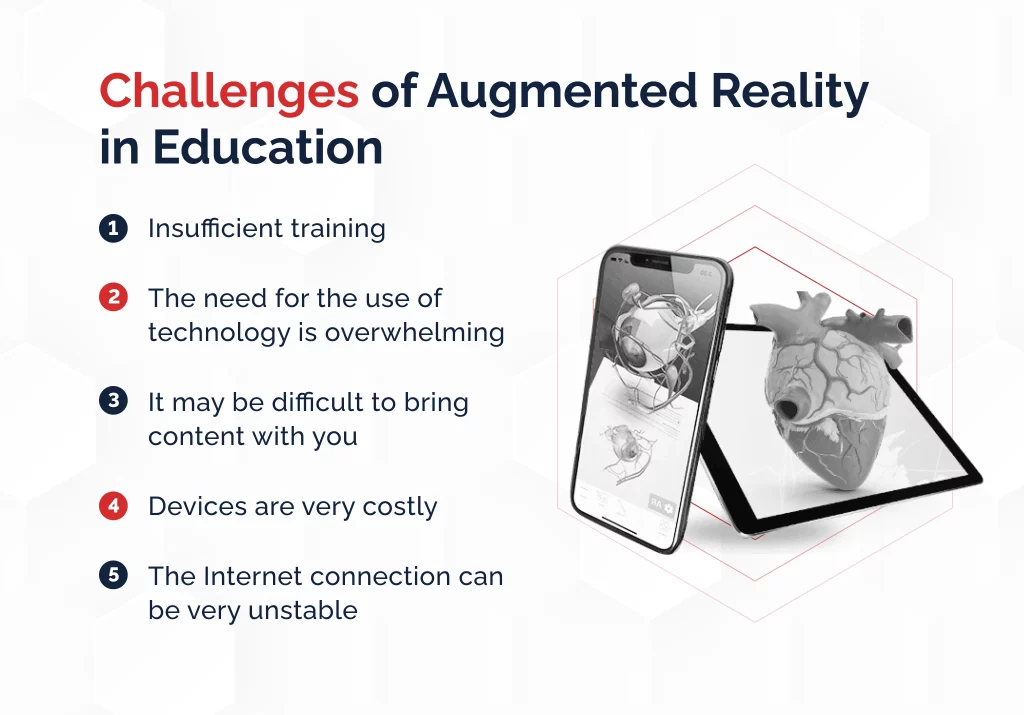
Insufficient training
The first big problem of augmented reality in education is the lack of experience regarding it. In many cases, teachers simply don’t know how to use it in educational settings. As a result, the problem results in the inefficient use of the technology and the creation of a negative reputation around it.
The need for the use of technology is overwhelming
To have a complete learning experience with AR technology, you MUST have a smartphone or at least a PC. What if some students use a feature phone? Well, they’re excluded from your classroom. AR is very dependent on technological adoption.
It may be difficult to bring content with you
Even though augmented reality and education seemingly benefit each other by enabling distance learning, they can also impede one another. How is that possible? Above all, due to the fact that some content pieces can be tailored to a classroom. In short, you can be stuck with the configuration you have for a certain classroom environment.
Devices are very costly
Smartphones capable of running AR are still not as numerous as may seem. As a result, the problem is that you heavily depend on the affluence of your students. Not everyone has a smartphone today that is capable of AR. Hence, you risk closing access to education for many students. Collaboration with teachers may also be restricted.
The Internet connection can be unstable
Many AR technologies depend on the ability to connect to online servers. What if you don’t have the Internet? Well, your augmented reality and education experience is likely to be over. Have a class and don’t have an online connection? Education should be very difficult to continue in such spaces.
The Future of Augmented Reality in Education
The augmented reality in education has a very strong future ahead of it. Indeed, some challenges of augmented reality in education mentioned above exist and they’re serious. However, we don’t see anything that should be impossible to solve. Reliance on the Internet can be removed and technological development should make most of the smartphones in the world capable of using the relevant technology. With more complex programs being developed, the overall phenomenon would inevitably lead to the further proliferation of AR. In our opinion, it will soon enter almost every learning program in the world.
Wrapping Up
To summarize, AR in education is one of the best options you can consider for your classroom. It can develop a large number of additional tech skills, for example, among the students. Don’t hesitate to use the technology today and become a leader in its utilization. In this regard, the good idea is to use the help of experts. Our company, Keenethics, can provide you with all the relevant help regarding augmented reality in education. Do you have any questions on AR in education? Write us, and we’ll do our best to find a solution!
If you want to enhance your apps or ensure that your business stays relevant in the future, apply to AR technology. Contact us, and we’ll offer you the best solutions for an AR education application.
FAQ
What is the application of AR in education and training?
The use of augmented reality in education and training brings numerous benefits for its users. AR improved the entire learning process by providing the learners with accessible educational materials. Also, the educators shouldn’t worry about the financial and technical side of regular updates to outdated learning programs. By integrating AR into education and training, teachers can create a unique, personalized learning journey in an interactive format available 24/7. Throughout interactive and gamified programs, learners are more interested in learning since their focus is on practice. Using headsets and goggles to practice is much more fun than traditional teaching methods like seminars and classes. Finally, AR isn’t limited to a specific subject, age group or educational level. It’s a beneficial way of learning for any learner in any field.
What is the role of augmented reality in the classroom?
Augmented reality is applied in different classroom subjects, adding gaming elements and virtual examples to support classroom programs. AR is versatile in many different fields of study. In paleontology, students can learn about specific species (for instance, dinosaurs) from different 3D angles with additional explanations. In history, students can take exciting VR and AR routes. Google Expeditions covers a vast number of subjects and offers more than 100 tours. In medicine, AR visualizes complex biological processes and abstract concepts and helps to learn the topics closely. In engineering and technology, students can visualize construction projects, design and test machines in real time. Through interaction with the learning program and material, students better retain their knowledge about the course. As AR advances, the role of technology is expected to grow in many industries. There is demand, and there is also an offer.
How to use augmented reality in online classes?
The effective use of AR has the potential to enhance students’ academic performance, proficiency, and enthusiasm for learning. The learners aren’t more passive recipients of the subject. They can participate proactively with the learning content and educators. Learners can use their devices, like smartphones, tablets, and headsets, to transform traditional material into AR-based content through the app. For instance, through the app, they can scan a QR code on a textbook to see a 3D model of some object on their screen, or they can use an AR headset to see a virtual tutor explaining some new concepts or a math problem to them.
What are the four difficulties in using AR in education?
Although AR provides us with many benefits and opportunities, it also has some challenges. When integrating AR into education, you should consider technical issues such as AR device compatibility, internet connectivity, battery life, and storage capacity. The teachers may face pedagogical-related issues like the efficiency of AR content and its alignment to their program with a focus on learning objectives, efficient learning activities, and AR integration with other traditional methods and learning styles. Cost may be a challenge for institutions with limited budgets. To know how to integrate technology effectively, they need to have technical skills. So, the training for educators and students is a necessary stage for getting much of it.
But despite the above-mentioned difficulties, the use of AR is continually advancing among businesses, and these issues still need to be defined with consideration of other external factors. We have in-house, dedicated professionals who know all the ins and outs of AR app development. If you want to get professional advice concerning your vision, contact us, and we’ll guide you through every stage of AR development until the product release. You can always entrust your vision to Keenethics; our experts, with years of tech expertise, are ready to develop the AR product for businesses of any size that is suitable for your end goals.

